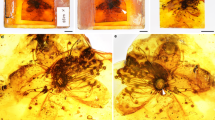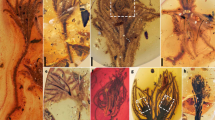Abstract
Fossils preserved in amber may provide significant palaeoevolutionary and biogeographical data regarding the evolution of life on Earth1. Although amber is particularly noted for its detailed preservation of arthropods, the same degree of preservation can be found for vascular plant remains2. Mid-Tertiary Dominican amber is a rich source for such fossils, and representatives of several angiosperm families have been described. However, no fossilized examples of the large asterid plant clade have yet been reported. Here we describe the first fossil neotropical flowers found in amber from a representative of the asterids. The asterids are one of the largest lineages of flowering plants, containing groups such as the sunflower, potato, coffee and mint families, totalling over 80,000 species3. The new fossils are only known as flowers, more precisely corollas with stamens and styles. We here describe them as a new species, Strychnos electri sp. nov, in the plant family Loganiaceae (Gentianales).
This is a preview of subscription content, access via your institution
Access options
Subscribe to this journal
Receive 12 digital issues and online access to articles
$119.00 per year
only $9.92 per issue
Buy this article
- Purchase on Springer Link
- Instant access to full article PDF
Prices may be subject to local taxes which are calculated during checkout


Similar content being viewed by others
References
Poinar, Jr, G. O. 1992. Life in Amber (Stanford Univ. Press, 1992).
Poinar, Jr, G. O. & Poinar, R. The Amber Forest (Princeton Univ. Press, 1999).
Stevens, P. F. Angiosperm Phylogeny Website (2001–2015); http://www.mobot.org/MOBOT/research/APweb/orders/ranunculalesweb.htm#Eudicots
Struwe, L. in Flowering Plants of the Neotropics (eds Smith, N. et al.) 219–221 (Princeton Univ. Press, 2004).
Frasier, C. L. Evolution and systematics of the angiosperm order Gentianales with an in-depth focus on Loganiaceae and its species-rich and toxic genus Strychnos PhD thesis, Rutgers Univ. (2008).
Krukoff, B. A. American species of Strychnos. Lloydia 35, 193–271 (1972).
Leeuwenberg, A. J. M. The Loganiaceae of Africa. VIII. Strychnos III. Meded. Landb. Hogesch. Wageningen 69, 1–19 (1980).
Iturralde-Vinent, M. A. & MacPhee, R. D. E. Age and paleogeographic origin of Dominican amber. Science 273, 1850–1852 (1996).
Schlee, D. Das Bernstein-Kabinett. Stuttg. Beitr. Naturkd. 28, 1–100 (1990).
Magallón, S., Gómez-Acevedo, S., Sánchez-Reyes, L. L. & Hernández-Hernández, T. A metacalibrated time-tree documents the early rise of flowering plant phylogenetic diversity. New Phytol. 207, 437–453 (2015).
Wikström, N., Kainulainen, K., Razafimandimbison, S. G., Smedmark, J. E. & Bremer, B. A revised time tree of the Asterids: establishing a temporal framework for evolutionary studies of the coffee family (Rubiaceae). PLoS ONE 10, e0126690 (2015).
Liogier, A. H. La Flora de la Española Vol. 5 (San Pedro de Macorís, 1989).
Poinar, Jr, G. O. Hymenaea protera sp. n. (Leguminosae: Caesalpinioideae) from Dominican amber has African affinities. Experientia 47, 1075–1082 (1991).
Angiosperm Phylogeny Group. An update of the Angiosperm Phylogeny Group classification for the orders and families of flowering plants APG III. Bot. J. Linn. Soc. 161, 105–121 (2009).
Merckx, V. S. et al. Phylogenetic relationships of the mycoheterotrophic genus Voyria and the implications for the biogeographic history of Gentianaceae. Am. J. Botany 100, 712–721 (2013).
Olmstead, R. G. Phylogeny and biogeography in Solanaceae, Verbenaceae and Bignoniaceae: a comparison of continental and intercontinental diversification patterns. Bot. J. Linn. Soc. 171, 80–102 (2013).
Chaney, R. W. & Sanborn, E. I. The Goshen Flora of West Central Oregon Vol. 439, 1–237 (Carnegie Inst. Washington Publ., 1933).
Wood, B. L. The Geology of the Gore Subdivision Vol. 53, 1–128 (New Zealand Geol. Survey Bull., 1956).
Acknowledgements
The authors graciously thank K. Gandhi of Harvard University for help with Latin nomenclature and D. Bhattacharya of Rutgers University for comments on an earlier version of this article.
Author information
Authors and Affiliations
Contributions
G.O.P. provided the data and analysis of the amber fossils (measurements and morphological data), all photographs except the extant Strychnos species and was the primary author for the palaeontological parts of the manuscript. L.S. provided data, photo and text regarding extant taxa in the Gentianales and other asterids, evaluation of asterid dating times and was the primary author of the new species description.
Corresponding authors
Ethics declarations
Competing interests
The authors declare no competing financial interests.
Rights and permissions
About this article
Cite this article
Poinar, G., Struwe, L. An asterid flower from neotropical mid-Tertiary amber. Nature Plants 2, 16005 (2016). https://doi.org/10.1038/nplants.2016.5
Received:
Accepted:
Published:
DOI: https://doi.org/10.1038/nplants.2016.5
This article is cited by
-
The largest amber-preserved flower revisited
Scientific Reports (2023)



